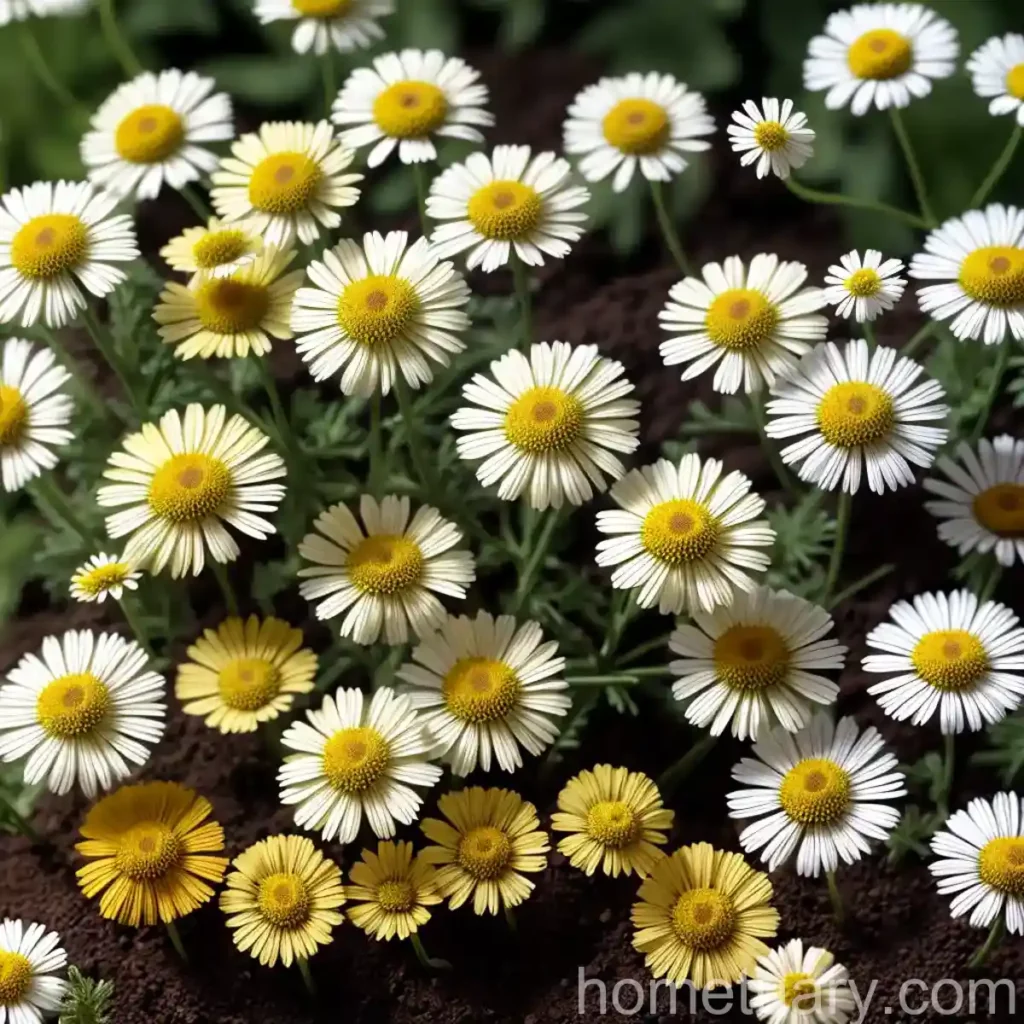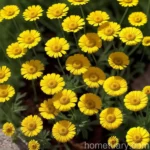Plant Scientist’s Guide to Dyer’s Chamomile (Anthemis tinctoria ‘Kelwayi’)
Dyer’s chamomile (Anthemis tinctoria ‘Kelwayi’) is a delightful perennial herb that is not only visually appealing with its daisy-like flowers, but also has a rich history of use for natural dyeing and medicinal purposes. In this comprehensive guide, we will explore the cultural aspects, growth requirements, uses, and care essentials for this charming plant. Whether you are a novice gardener, a seasoned horticulturist, or someone interested in sustainable natural dyeing, this guide will provide you with all the information you need to cultivate and appreciate Dyer’s chamomile to the fullest.
What is Plant: Dyer’s Chamomile (Anthemis tinctoria ‘Kelwayi’)
Dyer’s chamomile, scientifically known as Anthemis tinctoria, is a member of the Asteraceae family and is native to southern and western Europe. This perennial herb is known for its bright and cheerful yellow, daisy-like flowers that bloom profusely from late spring to early summer, adding a vibrant pop of color to any garden or landscape.
The specific cultivar ‘Kelwayi’ is highly esteemed for its enhanced vigor, larger flower size, and rich golden-yellow blooms. This cultivar has provided gardeners and natural dye enthusiasts with a reliable source of color and beauty, making it a popular choice for both aesthetic and practical reasons.
Key Takeaways – Dyer’s Chamomile (Anthemis tinctoria ‘Kelwayi’)
Before delving into the specifics of cultivating Dyer’s chamomile, let’s highlight the key takeaways for easy reference:
- Plant Name: Anthemis tinctoria ‘Kelwayi’
- Other Names: Kelwayi chamomile, Dyer’s chamomile flower
- Cultivation Uses: Aesthetic appeal, natural dyeing, medicinal purposes
- Common Uses: Garden borders, natural dye production, herbal remedies
Now, let’s explore in detail the various aspects of cultivating and caring for Dyer’s chamomile.
Culture
Understanding the cultural requirements of Dyer’s chamomile is crucial for its successful growth and development. Let’s discuss the key cultural considerations for this plant.
Water
Dyer’s chamomile thrives in well-drained soil and prefers moderate moisture levels. Once established, it exhibits good drought tolerance, making it an ideal choice for water-wise gardening. Avoid overwatering the plant, as it is susceptible to root rot in waterlogged conditions.
Sunlight
This herbaceous perennial thrives in full sun, requiring at least 6-8 hours of direct sunlight per day for optimal growth and prolific flowering. In regions with excessively hot temperatures, some afternoon shade may be beneficial to prevent stress and excessive wilting.
Fertilizer
Dyer’s chamomile is not particularly demanding when it comes to fertilization. A moderate application of a balanced, slow-release fertilizer in early spring can provide the necessary nutrients for healthy growth and flowering. Alternatively, incorporating organic matter into the soil during planting can supply the plant with the required nutrients.
Soil
Well-drained, loamy soil with a slightly alkaline to neutral pH is ideal for Dyer’s chamomile. It is adaptable to various soil types, including sandy, gravelly, and clay soils, as long as they are well-drained. Ensure proper soil preparation, including amending heavy clay soils with organic matter to improve drainage and aeration.
Pruning
Regular deadheading of faded flowers not only encourages the production of new blooms but also prevents the plant from self-seeding excessively. Additionally, light pruning after the main flowering period can help maintain a compact and tidy appearance, promoting the plant’s overall vigor.
Propagation
Dyer’s chamomile can be propagated from seed, division, or softwood cuttings. Seeds can be sown directly in the garden in early spring or late summer, while division and cuttings are best performed in early spring. The plant readily self-seeds, so be mindful of its potential to naturalize in the garden.
For optimal results, it is advisable to provide a consistent moisture level during the germination period, ensuring the soil is kept evenly moist but not waterlogged.
Container Popularity
Dyer’s chamomile is well-suited for container cultivation, particularly for gardeners with limited space or those wanting to enjoy its beauty on patios, balconies, or decks. When grown in containers, ensure the use of well-draining potting mix and adequate drainage holes to prevent waterlogging.
Container
A depth of at least 12 inches (30 cm) and a diameter of 18 inches (45 cm) are recommended for growing Dyer’s chamomile in containers, allowing ample space for root development and stability. Choose a container that can accommodate the plant’s robust growth and provide room for the roots to spread.
Common Diseases
While Dyer’s chamomile is relatively resilient, it can be susceptible to certain diseases under unfavorable growing conditions. Below are some common diseases that may affect this plant:
- Powdery Mildew: Occurs in humid and poorly ventilated conditions, leading to a powdery white coating on the leaves and stems.
- Botrytis Blight: Thrives in damp environments, causing gray mold on flowers and foliage.
Disease Diagnosis
Timely diagnosis and intervention are essential in managing plant diseases effectively. If you notice any signs of disease, such as abnormal discoloration, wilting, or unusual growth patterns, it is important to promptly identify the issue and implement appropriate control measures.
Common Pests
Dyer’s chamomile is relatively resistant to most pests; however, it may occasionally encounter pest challenges such as aphids, spider mites, and whiteflies. Regular monitoring and early intervention are critical for mitigating pest infestations and preventing damage to the plant.
Botanist’s Tips
As a seasoned plant scientist, I have gathered some valuable tips to ensure the successful cultivation and care of Dyer’s chamomile:
- Provide well-drained soil to prevent waterlogged conditions, which can be detrimental to the plant’s health.
- Deadhead spent flowers regularly to promote continuous blooming and prevent excessive self-seeding.
- Monitor the plant for signs of pests and diseases, addressing any issues promptly to maintain its health and vigor.
- Consider incorporating Dyer’s chamomile in mixed borders or as part of a naturalistic planting scheme to enhance its aesthetic appeal and ecological function.
Fun Facts
Let’s explore some fascinating and lesser-known facts about Dyer’s chamomile:
- The flowers of Dyer’s chamomile yield a brilliant yellow dye, traditionally used for coloring textiles and natural fibers.
- Dyer’s chamomile has been utilized for centuries in herbal medicine for its soothing and calming properties, often used to prepare herbal infusions and topical preparations.
- This plant is an excellent attractant for pollinators, including bees and butterflies, contributing to the ecological diversity of the garden.
Links to External Resources
For further detailed information on Dyer’s chamomile and related topics, kindly refer to the following external resources:
- Royal Horticultural Society – Anthemis tinctoria ‘Kelwayi’
- Missouri Botanical Garden – Anthemis tinctoria
- University of Vermont Extension – Dyeing with Anthemis tinctoria
- The Herb Society of America – Anthemis tinctoria
- Gardening Know How – Growing Dyer’s Chamomile
Continued in next comment…















